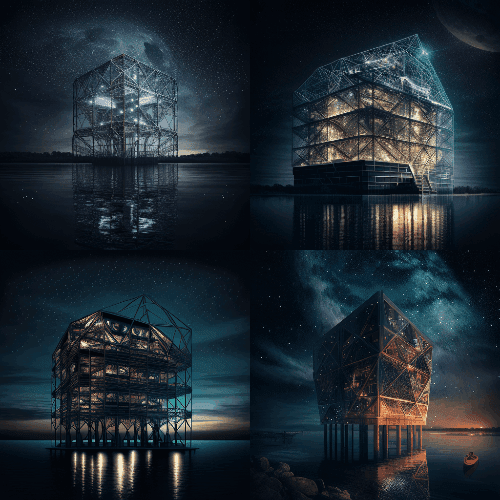

Portfolio 2023

AI Water Pavilion Architecture
The proposed architecture consists of a large pavilion over the water whose tectonic aspect presents a super structure made of steel scaffolding. The architecture is in an isolated environment, in an open landscape, which allows for a beautiful starry night.

(In)visibility in the Rio de Janeiro necropolis: space for memory and reflection in the killing city
The idea of the project stems from the intention of creating a space for memory and reflection regarding the theme of necropolitics (a concept by philosopher Achille Mbembe) in Rio de Janeiro. Bearing in mind the issue of invisibility, necropolitics and the occupation of a space of power, this work proposes a temporary installation at Praça XV (XV Square, a major space located in the central region) that symbolically constitutes itself as a manifest space against necropolitics in Rio de Janeiro and that builds an articulated narrative that makes the viewer aware of the political and social context in which it operates. The project was implemented in grid layout and occupies the space between the Imperial Square and a fountain built by Mestre Valentim, a great artist of the 18th century. The grid represents the modern reasoning criticized by Mbembe, who argued that the Enlightenment thought established a modus operandi that legitimized the discourse of violence for the sake of order. The grid was designed based on the measurements of the current Imperial Square (approximately 30m x 90m, with a patio measuring 15m x 18m). From the grid, the elements were arranged to create an artificial, rigid and ordered nature. That nature (waterfall, river, sea and mist) is mainly composed of a red fluid that represents blood and which, in turn, embodies many symbolisms, mainly violent death. Nature refers to the landscape of Rio de Janeiro and its strength, and its artificiality represents the idea of sovereign power delimiting a cycle that should be natural, just like the cycle of life. Thus, that stiffened flow alludes to the idea that sovereignty does not entitle people to have control over their own lives. The project aims to provoke sensations such as discomfort and disorientation and, therefore, lead the spectator to assume an active attitude towards the space in which he transits. In this way, an attempt is made to establish an interval, a break necessary to give space for reflection, which is so important that people can understand their position within society and the environment in which they live. A system of tubular structures was chosen as the main method of construction of the architectural project, as it presents an almost chaotic lightness and translucency. The material configures and delimits the entire intervention space and serves as a support for directing the red fluid. By means of the grid, support points formed by a scaffolding structure are arranged, and those points form, in their core, translucent cubes that contain the red fluid at various heights. Those points are arranged at grid intersections and represent human bodies intercepted by necropolitics. Each point also serves as a support for people to pay homage by pasting photos and writing names of victims of the necropolis. In addition, each of the 28 points is named with dates that represent some emblematic events that reveal the role of necropower in the city of Rio de Janeiro. Those dates represent milestones such as the period of slavery, the military dictatorship, cases such as the murder of city councilor Marielle Franco, in addition to some of the main massacres and other violent events. The support points hold a structure that follows the 15m x 15m grid consisting of a tubular structure (box truss 50) and has, inside, channels that carry the red fluid from the fountain to the waterfall. That structure is arranged 2 meters above the ground in order to cause a feeling of proximity and discomfort on the passersby. The waterfall, in turn, is located in the courtyard of the Imperial Square and is structured by a cube of scaffolding. The fluid flows down the waterfall, follows a sheet of water that represents the river and which is contained by two rows of scaffolding arranged 2 meters apart, and continues towards the fountain, where it flows into a space that once was the sea, in order to represent the arrival of violence through that space. Finally, the red fluid returns through the channels that follow the grid, resuming the cycle. At the end of each cycle, at each moment of arrival and departure of ferries from the Praça XV station, the channel structure disperses water droplets in the air and creates a dense mist that takes over the entire pavilion by means of sprinklers. That water vapor transforms the so defined and stable structure into an architecture that is almost dematerialized, unstable, transitory and without significant weight. Furthermore, it makes the boundaries fuzzy and the vision blurred so that a process of dissolution and disintegration ensues. It is, therefore, a hybrid object in its essence that interacts with the fields of architecture (as infrastructure), sculpture (as object and symbology) and performance (in its ephemerality, noise and representation). In this way, the final act of each cycle represents the transience of life and, at the same time, disorientation becomes the rule and demonstrates how necropower, despite operating in orderly ways, is diffused in the eyes of society. Architecture poses itself as a tool for social and political revelation.